Recentering the Bay of Bengal. Connected spaces in an inter-Asian bordersea
The interconnected world history of the Bay of Bengal is re-enacted in people’s memories, habits and everyday practices. The word for ‘star anise’ in Central India is Singapoor ke phool [Singapore flower], a colloquial echo of a pre-modern network of maritime trade. The Bengali word for window [janala] is directly borrowed from Portuguese, a reminder that language witnessed the syncretic impact of early European settlements around the Bay. Epic stories from the Ramayana, originating in ancient India, are re-enacted daily in Javanese traditional theatre. These are just a few of the examples that can serve as metaphorical mappings of the past and present of a network of interdependent livelihoods, a busy seascape, and a web of littoral hubs, which constitute the life of the Bay of Bengal.
The Bay of Bengal, a web of maritime highways as well as a chessboard of relationships and mobilities, is a vital region for several countries; both littoral (India, Bangladesh, Myanmar, Thailand, Sri Lanka, Thailand) and landlocked (Nepal, Bhutan, China, Northeast India, Nepal). Often disregarded as the periphery and the liquid borderland between South Asia and Southeast Asia – two macro areas that came to define much of the modern scholarship about this region – the Bay of Bengal can be seen as the nodal crossroad and the cultural hub for a network of exchanges and contacts of diverse kinds.
In the new millennium, the Bay has emerged as a significant subject of debate in popular as well as academic discourses, particularly with rising sea levels, and attention to maritime trajectories in policy approaches of different Asian states in and around the region. This waterscape has been characterized by an absence of any major territorial conflicts or claims; perhaps one of the reasons for traditionally receiving less attention – in the larger realm of Indian Ocean studies – than the western Indian Ocean region. Yet, the eastern Indian Ocean has been one of the busiest seascapes, with overlapping circuits of interaction between the regional nodes of exchanges and the global economic order. The ‘monsoon winds’ established and connected the dominant trade routes and shaped migratory trends till the onset of colonial intervention and consequent introduction of steamship navigation. European trading settlements, experiments and ambitions, left a trace of Portuguese, Dutch, Danish, French, British and other presences. A successive period of colonial intrusion and governance both separated and united communities, commodities, cultures and ideas across the region. The hegemonic (British) colonial domination over the seascape and adjoining hinterlands and littorals was often achieved through destruction and violence. Yet, administrative subjugation also generated a sense of unity in the Bay. This complex area has thus witnessed multiple and mutual borrowings across the seas, littorals and borderlands, with strong legacies of circulations in culture, economy, life-style and languages.
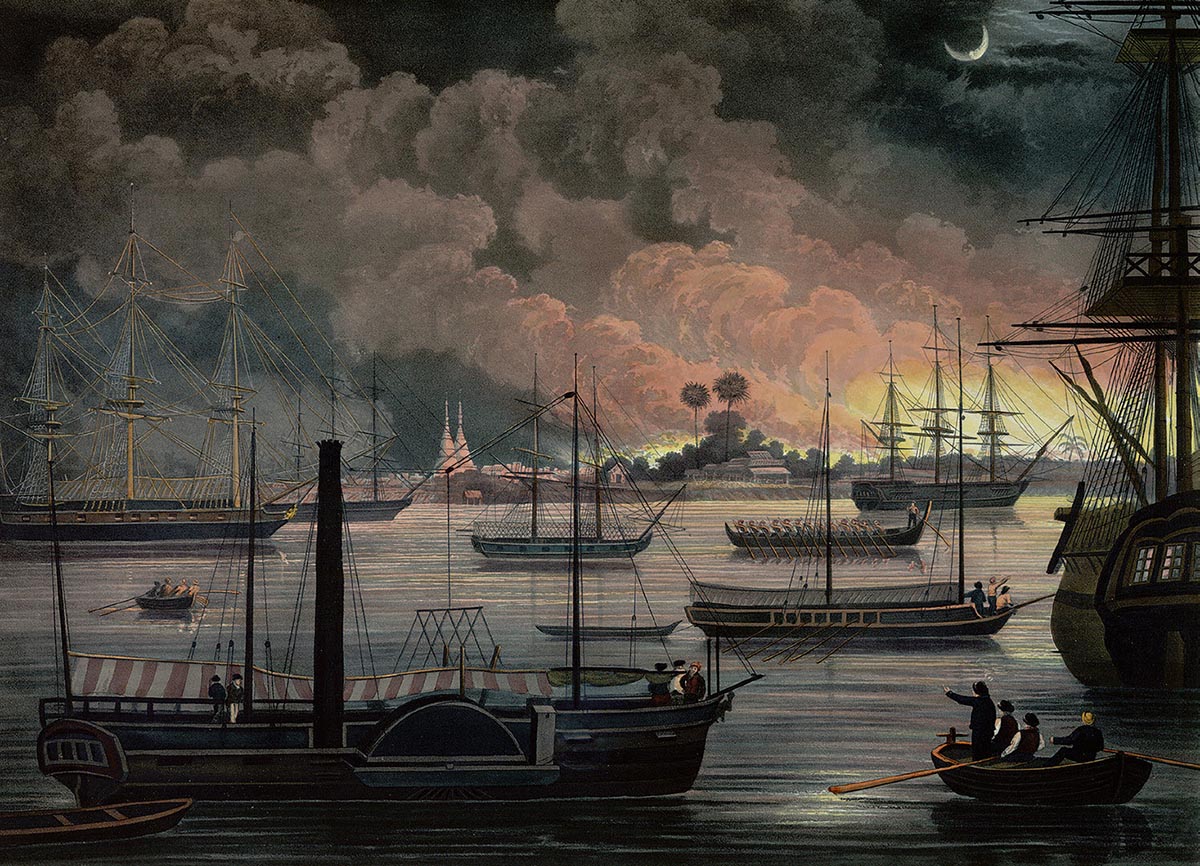
The Conflagration of Dalla, on the Rangoon River. From Series 1 of ‘Views taken at or near Rangoon, and Combined operations in the Birman Empire’, by Lieutenant Joseph Moore. Description: Plate 17: moonlit river view, with smoke rising from fire on the right horizon, near pagodas, seen from the river in the foreground where ships and boats are mooring or rowing, some figures on them spotting the fire. Year: 1826. Hand-coloured aquatint with etching.
However, porous borders and circular migrations slowly turned into isolationism and rigidly monitored frontiers in post-colonial Asia, with the emergence of decolonized geopolitical territories, the dominance of nation-centric visions and inward-looking policies for most of the states around the rim of the Bay. Borderlands and borderseas were divided into South and Southeast Asian states, a binary conception that became deeply embedded in academic, political, and public discourses. It is only recently that increasing globalization and inter-state interactions have facilitated looking beyond the conventional categories sanctioned by the history of Area Studies. The Bay of Bengal thus emerges as an incredibly fertile field of inquiry as an in-between space of borrowings, contacts and interactions that shape the vision of the past, the present and the future of a considerable part of the global population. Moreover, the increasing importance of borders, borderlands and trans-border studies in academic discussions1 has often laid more emphasis on mainland ‘barbed-wire borders’ rather than on maritime borders, shared maritime heritages, and the hydroscapes of bordering regions, pointing to another lacuna that our focus on the Bay of Bengal region aims to fill.2
A new phase of Bay of Bengal studies: economic and cultural contexts beyond geopolitical strategy
This Focus section of The Newsletter has been inspired by the need to emphasize the spaces and trajectories between the two macro areas of South and Southeast Asia, strongly embedded in popular imagination and academic discourses. Transcending methodological nationalism, it focuses on transnational and transregional movements, practices and institutions that connect people, histories and knowledge across the Bay.
For example, present-day impermeable borders and nationalist rhetoric in countries like Burma and Bangladesh are better understood if compared to a long history of exchanges and colonial connections between the historical province of united Bengal and British Burma. Contrary to the dominant discourse in contemporary Myanmar, which strives to identify members of the Rohingya community as 'Bengalis' or foreign infiltrators, making way for a tragic humanitarian crisis, nineteenth and early-twentieth century histories of the Bay of Bengal demonstrate that the two regions were linked through common movements of resistance, intellectually constructed pan-Asian sentiments, but also mutually influenced by anti-colonial political activists.

A monsoon day in southern Bangladesh, June 2011.
Whereas mainstream popular discourses depict the Bay of Bengal as a strategic area both at the convergence of two geo-political blocks (ASEAN and SAARC) and at the confluence of two competing maritime powers (India and China), this special Focus considers not only the high politics but also the everyday lives of the Bay of Bengal by gathering perspectives from historical, anthropological, sociological, literary and multidisciplinary research.
The nine contributions by scholars from different disciplines and areas of expertise are based on the discussions held at a day-long intensive roundtable session at the 11th International Convention of Asia Scholars (ICAS) in Leiden, on 18 July 2019. The roundtable titled ‘The Bay of Bengal: Perspectives across Disciplines’, was divided into four different thematic clusters (‘Cosmopolitan Connections’, ‘Contested Heritages: Arts and Politics’, ‘Liquid Migration and Solid Borders’ and ‘Environment and Littoral Ecologies’) and featured fifteen participants from different parts of the globe, along with an enthusiastic international audience. The discussions consciously looked beyond the mainstream geopolitical debates that dominate the mediatized discourse around the eastern Indian Ocean. The participants focused instead on historicizing, contextualizing and problematizing the flows of people, ideas, livelihood and traditions. The presenters analyzed travel narratives, entangled histories, material culture and maritime heritage across the Bay. Rich in ethnographic detail, some of the papers discussed the local variants of environmental activism and ecological histories, the disruptions of coastal livelihoods, and the experiences of disconnection, forced migration and displacement, which also constitute the living fabric of the Bay of Bengal. Critically responding to an idealized and often romanticized focus on flows and connections around the Indian Ocean, the participants underlined the instances of inequality and power struggles that dictate connectivity or lack thereof within the Bay of Bengal region.
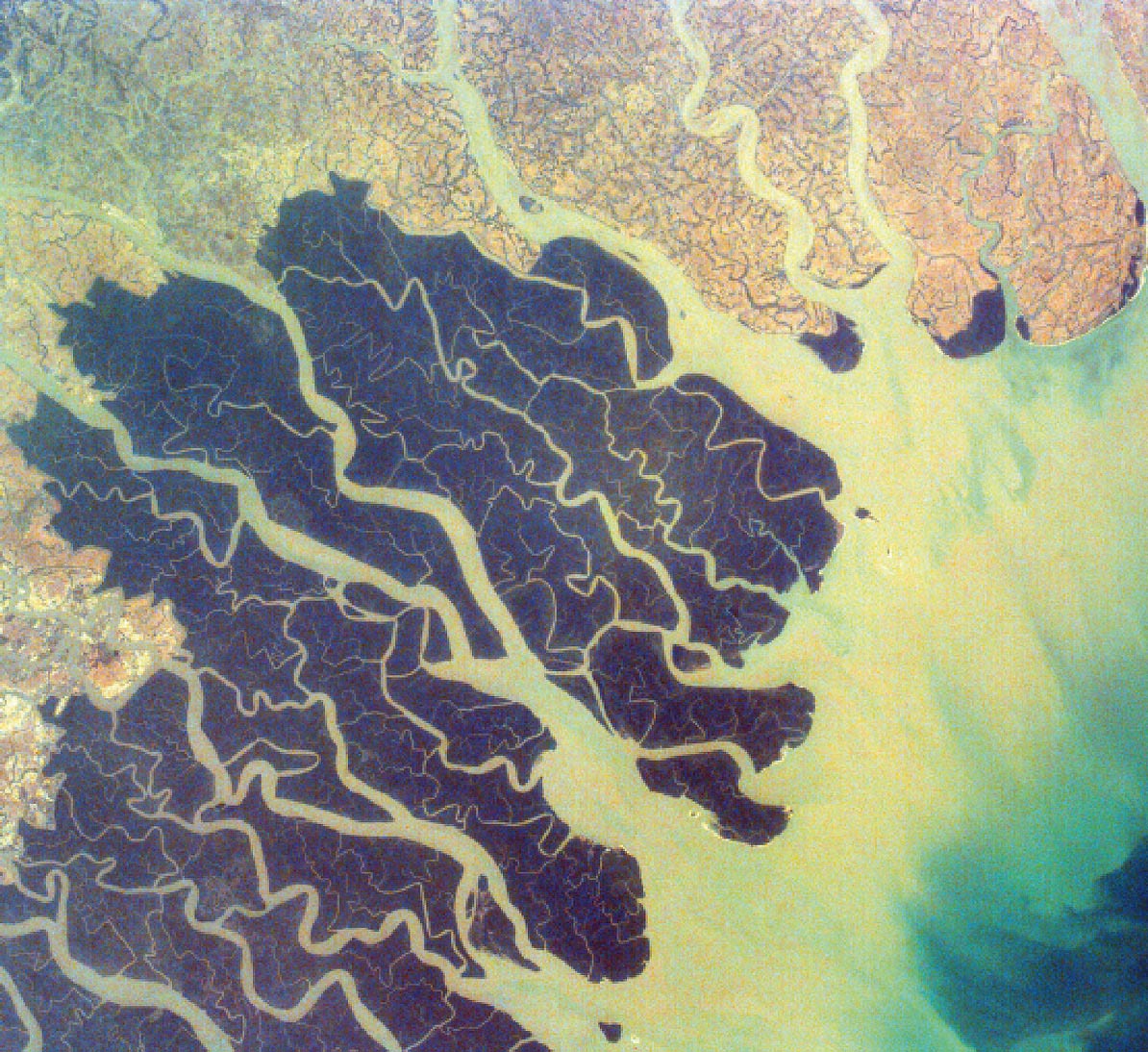
Ganges Delta. JPL space images. This image was taken from the Space Shuttle on January 13, 1997.
In the new millennium, the rise of China and India as emerging global powers and the restructuring of their respective foreign policies have steered and influenced regional geopolitical interactions in Asia, thus leading to the emergence of the Bay of Bengal as a significant subject of research in the larger realm of Indian Ocean studies. India’s Look East Policy (LEP), introduced in the 1990s led to a rediscovery of its historic ties with its eastern Asian neighbors and reintegration with a primarily maritime Southeast Asia. There was also a shift of policy orientation from the territorial to the maritime, the most prominent outcome of which was the big boost to the organization of the Indian Navy and naval installations. China’s rise as a potential global power had already been spectacular in different ways by then. In 2013, China announced the One Belt One Road (OBOR, now better known as BRI, Belt and Road Initiative) project that would connect the Mediterranean to the Pacific through a network of overland roads, pipelines, economic corridors and also maritime routes. Though we are not discussing Chinese or Indian foreign policies and strategies in this Focus, it is indeed significant that China’s Maritime Silk Road (MSR) plans to traverse the Bay of Bengal, implying the possibility of significantly impacting bilateral relations, economies and communities.
While the BRI is much larger in scale, vision and economic prowess, India’s LEP, later renamed as Act East Policy (AEP), has gained ground through its benign and non-assertive approach both within the region and further to the east. Partly as a joint attempt to counter Chinese assertiveness in their maritime borderseas, India and Indonesia are strengthening their ties, from economic, diplomatic and military angles. Their maritime partnership unfolds in the Bay of Bengal and in the Andaman Sea, with regular bilateral naval exercises, with the Indian endeavor to assist and access ports in Aceh, and with the expanding trading opportunities between Sumatra and Port Blair. Similar diplomatic endeavors are equally at play between India and other states around the rim of the Bay. The extent of this east-looking influence may be reverberated in the transformation of the rhetoric of ‘Asia-Pacific’ region into ‘Indo-Pacific’, introducing the concept of ‘extended neighborhood’ and claiming larger inclusivity of maritime and territorial spaces. Interestingly, India has not joined the grand vision of the BRI, and yet the Bay of Bengal region remains the converging ground of India’s Look/Act East Policies, and China’s ambitious MSR projects. Drawing in the participation of many located ‘outside’ its periphery, like the USA and Japan, these contemporary dynamics enhance geopolitical complexities and increase global attention for this waterscape.
Cosmopolitan connections, liquid borders, and endangered livelihoods
Looking at the history of communication, transportation and connectivity across the Bay, our contributors highlight a past of movements and mobilities populated by elite travelers, nationalist intellectuals, colonial proto-tourists, and upper-class locals. However, migration in the modern and early-modern Bay was also populated by subaltern people and marginalized communities, by laborers and pilgrims. This long history of subaltern migration connects the past to the present. For example, some of the contributors follow the history of migration and resettlement of indentured laborers and post-Partition refugees from mainland South Asia to the Andaman Islands.
Besides migrations and connections, the history of the Bay of Bengal is also a history of natural calamities and catastrophes, of unkind weather conditions and of tragic disruptions that mark the social and political history of maritime borderlands and islands. The 2004 tsunami, for example, acts as a watershed in the history of the Andaman and Nicobar Islands in terms of conservation policies, development of mass tourism, threats to vulnerable ecologies, and to the coastal livelihoods of fishermen and informal settlers.
The contributions in this Focus remind us that the northern Bay, spreading from the unique ecological reality of the Bengal Delta seamlessly into the Indian Ocean, is a space that challenges established notions of water, land, soil and sea. Whereas disciplines at the service of the Empire, such as cartography and oceanography, have striven to separate navigable sea from taxable land, the Bengal Delta defies these binary notions through its tidal landscape, its ubiquitous ponds, swamps and wetlands, its métissage of salt and fresh waters, and its cyclical reshaping of sandbars, flooded soil, temporarily emerged land, and submerged coastlines. Studying the nature and the human course around the Bay of Bengal, with its fluid and moving relation between water and land, can help us to shift conventional paradigms surrounding land-water visions, a starting point to secure the future of coastal cities in a world of rising waters.
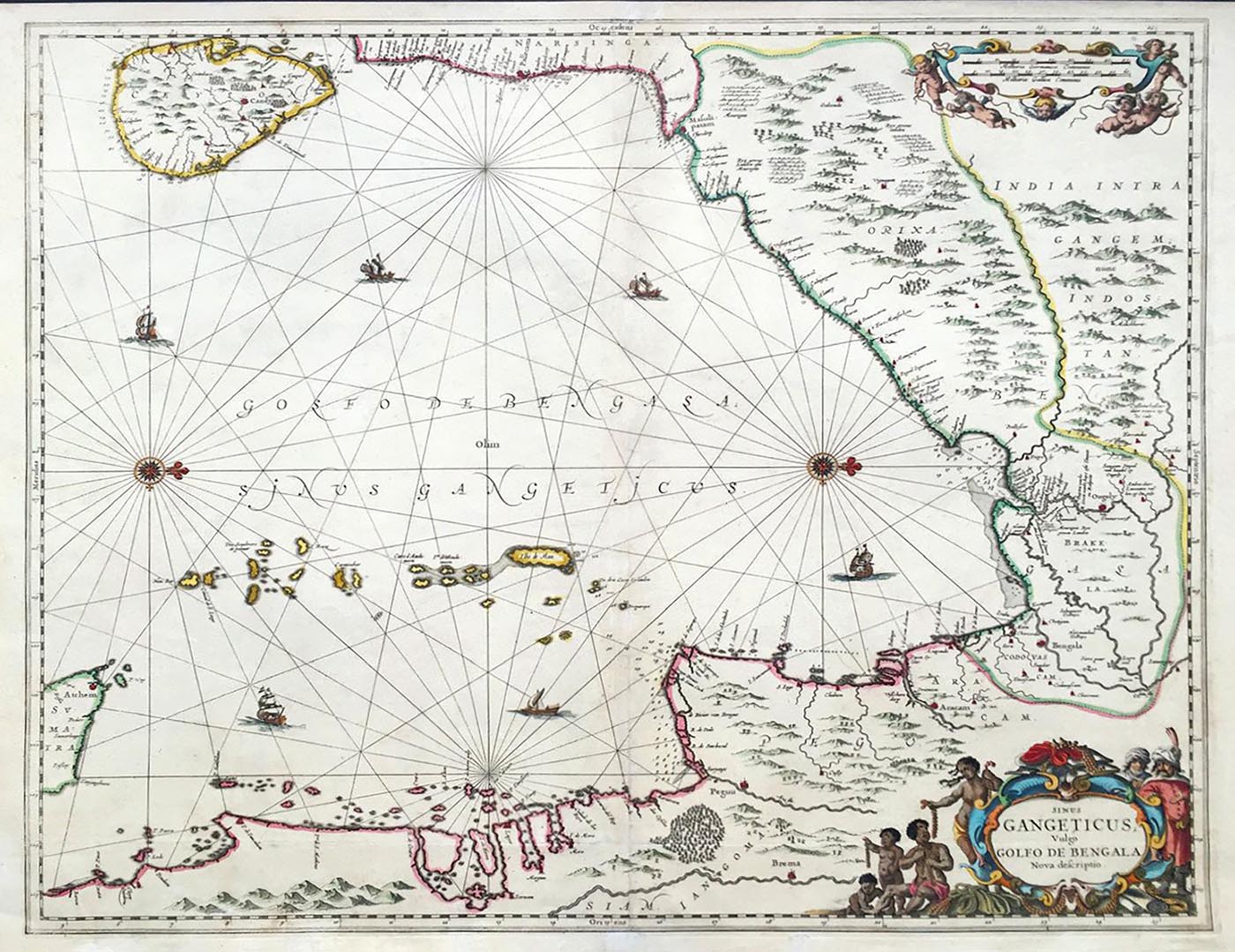
A 1650 map by Jan Jansson of ‘sinus gangeticus’, or the Bay of Bengal. Titled Sinus Gangeticus, vulgo Golfo de Bengala nova descriptio, printed in Amsterdam: Apud. I. Ianssonium, 1657.
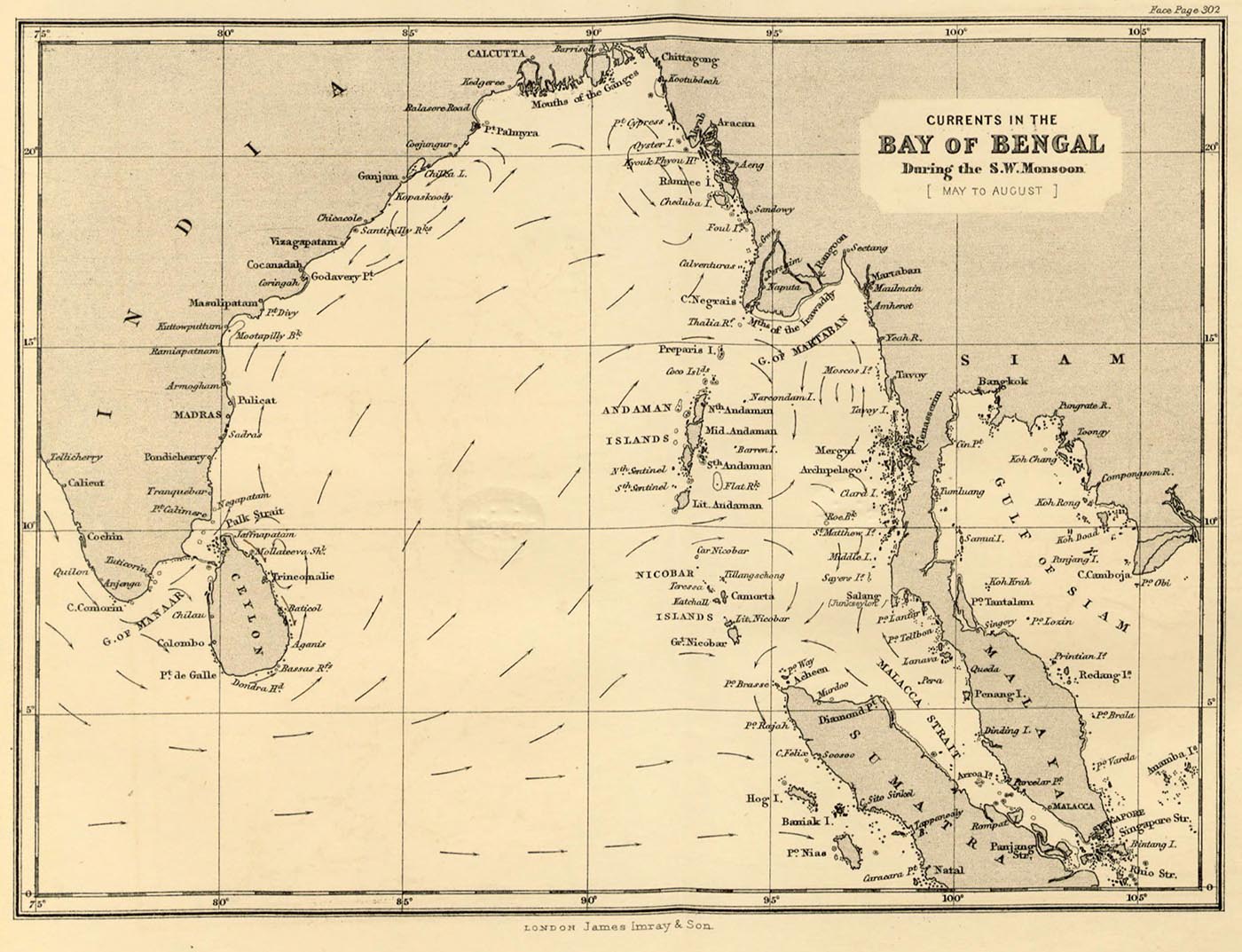
Currents in the Bay of Bengal. From ‘The Bay of Bengal Pilot: A nautical directory’. Compiled by James F. Imray. London, 1879. Page 341.
The backwaters of the Bengal Delta, with their forbidding wilderness, thick forests, merciless salinity and natural impediments, discouraging settlement and cultivation, opened up to the markets and routes of the Bay of Bengal and the greater Indian Ocean long before the coming of European sea voyagers. This pre-European cosmopolitanism of trade across the Bay was not only made of traffic and exchanges between Malacca, Sumatra, Borneo, the Persian Gulf, Bengal and the Coromandel Coast, Sri Lanka and Malabar; but also of raids of pirates and fortune-hunters. This inter-littoral world of trade, of spices and fabrics, sugar and silk, sandalwood and muslin, preceded the advent of the big European overseas trading corporations. It is from this time period that our contributors retrace the steps of the social, cultural, economic and political history of the Bay of Bengal.
In this Focus
The articles of the Indian historians Sonali Mishra and Smarika Nawani look at the early-colonial life of port cities around the Bay and their importance in studying power dynamics, but also religious networks, and cultural etiquette. Sonali Mishra points out that neutrality regulated the trade regime of the cosmopolitan port of Masulipatnam, where Europeans, Asians and several indigenous merchants collaborated. Their opportunities transcended normative categories based on caste, religion, ethnicity and political belonging. She argues that this relative freedom in the complex socio-political milieu of the region, requires us to re-evaluate the parameters to understand the pre-modern state in South Asia. Smarika Nawami’s contribution focuses instead on the Portuguese presence around the Bay, which provided long-lasting cultural and linguistic influences, and on the town of Mylapore, a cultural heart of Catholic Christians for locals, Portuguese and Eurasians. Both articles highlight examples of cosmopolitanism and inclusive living of different communities in two different ports. The essence of similar co-existence continued into the colonial phase, particularly in the port cities around the rim of the Bay, like Penang, Singapore, Calcutta, Madras, Akyab, Rangoon, and Colombo.3
With the territorial establishment of the East India Company and the Dutch VOC in South and Southeast Asia, trajectories and interactions across the Bay of Bengal took a different shape. Mikko Toivanen’s contribution looks at specific transport nodes at Singapore, Penang, Calcutta and Galle, extending to Batavia in the Dutch East Indies. Following the introduction of the steamship in the region, these points were closely connected by overlapping circuits of trans-colonial elite travelers seeking leisure, convalescence, healthier climates, and sightseeing. Their experiences are embedded in a colonial reinvention and re-appropriation of local spaces and local histories as culturally ‘European’. This created walls between the colonial (and local) elites and the subaltern local population on the one hand, but also fashioned and reproduced replicas of European-styled living in certain locales.
Linking ancient and modern sites of interaction across the Bay, Himanshu Prabha Ray’s article explores the stratified history of coastal shrines. Prior to the development of oceanography and the making of nautical charts, sailing vessels largely depended on coastal shrines and structures that connected the coast with communities living inland, while functioning as visible coastal markers and recipients of devotion. For example, a lighthouse was built in 1887 on top of the Mahishasuramardini cave at the Mahabalipuram temple complex on the Tamil coast in proximity to an older seventh century structure that had possibly served the same function. These coastal structures were religious spaces maintained by communities who lived close to them. Their distribution constitutes an important and yet underestimated mapping of the economic, social and religious life across the Bay.
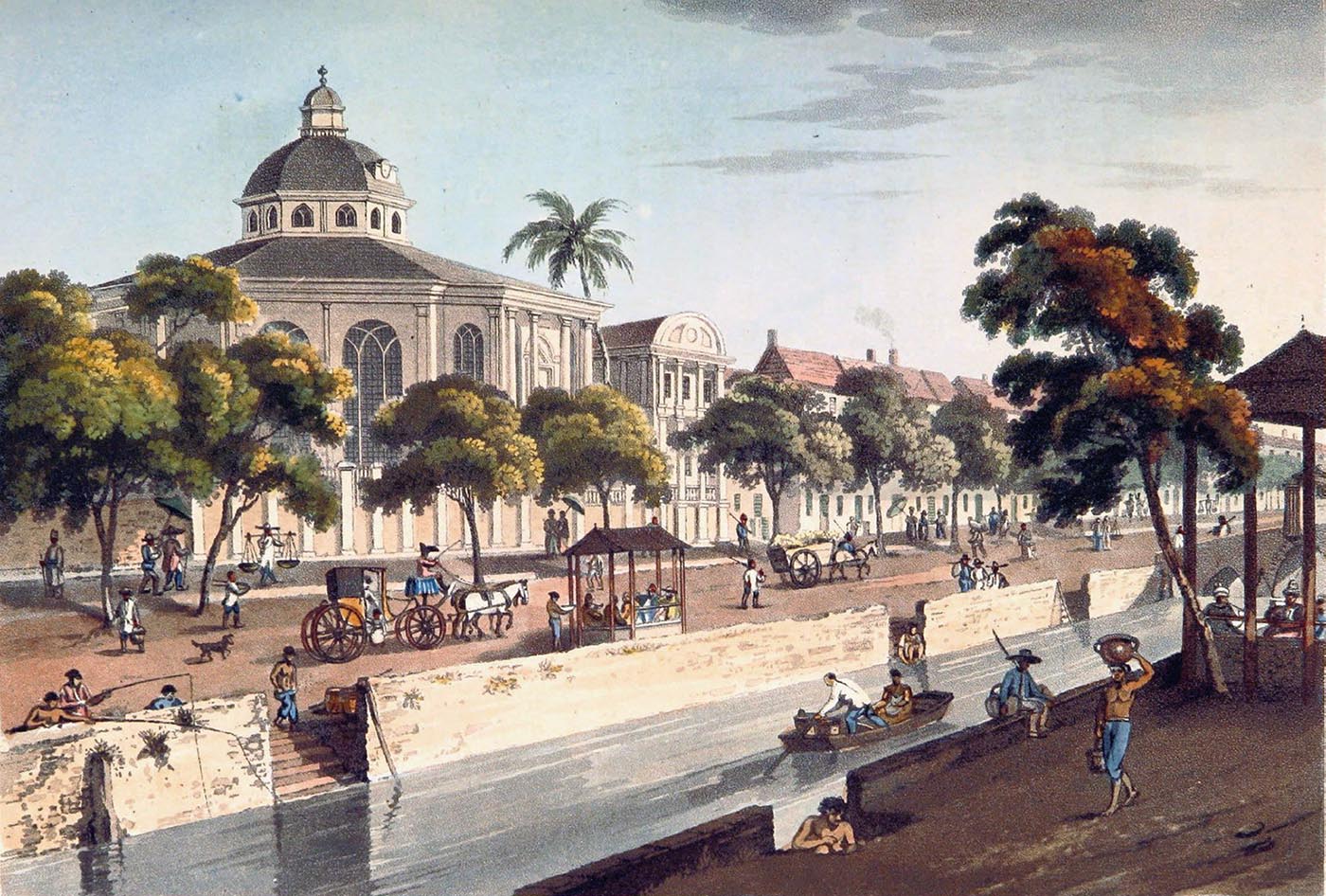
A Calvinist Church in Batavia. 1806. From "A Voyage to Cochin China, in the years 1792, and 1793” by Sir John Barrow, page 221.
The contributions of Sanjukta Dasgupta and of Maitrii Victoriano Aung Thwin explore connections and parallelisms between British India and British Burma. Maitrii’s article highlights the need to contextualize key events of national history, such as the 1930-1932 Burma Rebellion, in a transnationalist perspective that embeds local resistance movements within the larger scenario of rebellions and insurgency across the Bay. The Burma Rebellion (later called the Saya San Rebellion), the Chittagong Armory Raid (1930-1931) in Bangladesh, and the Malabar/Moplah Rebellion of southern India, in this view, can emerge as connected histories of the Indian Ocean. Sanjukta Dasgupta offers a precious reflection on Bengali travel accounts of Burma, with particular reference to the experiences and perceptions of Indumadhab Mallik, and Sarala Debi Chaudhurani, who demonstrate diverse, complex and layered approaches to the idea of Asia, determined by their own class sensibilities and specific social and political interests. Their response to visiting Burma and their comparisons between the self and the ‘other’ was to a large extent shaped by internalized Orientalist assumptions. Their views, however, are also a result of the contemporary nationalist rhetoric and Pan-Asian discourse. While they shared an understated, yet tangible antagonism towards the British, they had also internalized much of the racial and civilizational categories of the colonial gaze through which British rulers established cultural and political hegemony.
Bengali refugees and Burmese early settlers live side by side on the Andaman Islands, an emblematic site of the entangled national histories of India and Burma in the heart of the Bay of Bengal. Geographically and geologically closer to Burma, the Andaman and Nicobar Islands became an Indian Union Territory in 1956, although disputed sovereignty on some of the islands continued until 1986. Two of our contributions, both rich in ethnographic material, are dedicated to the contemporary history of the Andaman Islands through anthropological perspectives. Raka Banerjee explores the intersection of gender and migration in the language and the oral histories of the Bengali refugee women settlers on the Andamans. In a considerable departure from existing approaches in understanding the gendered experience of Partition-induced displacement, she argues that statist vocabulary permeates the settler women’s speech. These primarily English words – for example, riot, border slip, dole, colony, etc. – entered the unlettered Bangla-speaking women’s vocabulary because of the experience of forced migration from East Pakistan and resettlement in the Andaman Islands.
Equally resulting from extensive fieldwork, the contribution co-authored by Philipp Zehmisch and Ruhi Deol looks at the subsistence livelihoods of farmers, fishers, and forest villagers in post-Tsunami Andamans. The Tsunami exacerbated a shift in India’s state policies, from commercial exploitation to the conservation of resources. As in other parts of the globe, the conservation paradigm has created new vulnerabilities, especially related to human activity in marine and forest ecosystems. Their article reveals the ways in which aspects of the conservation discourse impact local perceptions of environmental change in the Andamans. The authors argue that the 2004 Tsunami functioned as a “revelatory shock” for the island population. Accompanied by the increasingly popular conservation paradigm and the rapid rise of tourism in the Andamans, the event of the Tsunami triggered both ecological awareness as well as debates on the vulnerability of the island ecosystem and its populace. In some respects, local migrants and settlers internalize these vulnerabilities; in others, they develop contextual ways to cope, respond, or adapt to their changing environment.
Climate change and the rising sea levels of the Anthropocene are problematically evident in the Sunderbans, the largest delta and estuarine mangrove forest of the world, shared between the southern coast of West Bengal (India) and Bangladesh. Calynn Dowler’s piece explores the Sundarbans as a changing waterscape, with particular attention to how the meaning of water in the Bengal delta is shifting as a result of intersecting socio-natural transformations. A focus on the materiality of the Bay of Bengal – its rivers, sea, estuaries, etc. – and on the everyday ways in which coastal communities engage with water, can challenge some of the flattening assumptions of global climate change discourse, allowing for a more nuanced understanding of human-nonhuman agency and the meaning of water for the ritual life of the delta.
The relevance and future avenues of Bay of Bengal studies
The articles in this Focus contribute to the understanding of the history, the socio-cultural ecologies, and the geopolitical interactions across the Bay, by adding complexity and texture to the public discourse around the strategic importance of the Bay of Bengal. Inspired by and indebted to the recent academic scholarship on the historical connections of the Bay,4 which is dominated by arguments of continuity and circularity of interactions throughout history, our contributors also seek to de-romanticize notions of transnational flows, and bring up instances of disconnections, disruptions, and unequal mobilities within and across the Bay.
Available scholarship on the region has already established that the Bay was never a static region, nor an impenetrable web of political boundaries, but interactions and power dynamics across the Bay in different time-periods played out in multifarious manners. Thus, the colonial port city connections of Calcutta, Penang, Singapore, Rangoon and Colombo, gave way to Chittagong, Sittwe, Hambantota, and Colombo, connecting the eastern section of the ‘String of Pearls’ in the contemporary politico-economic order. The increasing interest of the nations-states in the maritime resources of the region has added another dimension to the competition and collaboration, adding to the vulnerability of marginal people and delicate ecosystems. At an important juncture of history, when we are moving beyond strictures and demarcations of Area Studies, this platform provides us with an opportunity to explore transregional issues, cosmopolitan linkages and heritage, communities and cultural traditions. It also attempts to address the concerns of a post-disciplinary academia, encouraging inter-disciplinary research and influencing future pedagogical frameworks.
Keeping in view the significance of the region and tremendous possibilities of research, we aim to establish a long-lasting network of scholars from diverse disciplines across the humanities and social sciences. Sprouting from the fruitful discussions at the roundtable sessions during ICAS 11, this Focus in The Newsletter is the first concrete step in this direction. We have been receiving further expression of interest from different scholars and institutions, and our network is expanding quite rapidly, suggesting a very promising future for the studies of the Bay of Bengal as both a physical region and a conceptual framework.
Jayati Bhattacharya, Senior Lecturer, South Asian Studies Programme, National University of Singapore (jayati2@gmail.com);
Carola Erika Lorea, Research Fellow, Asia Research Institute, National University of Singapore (carola.lorea@gmail.com)